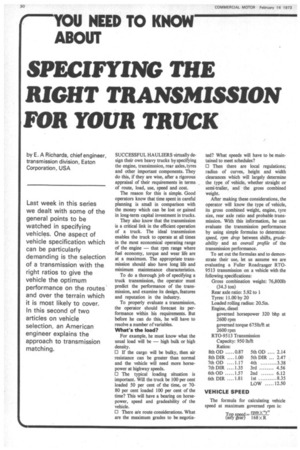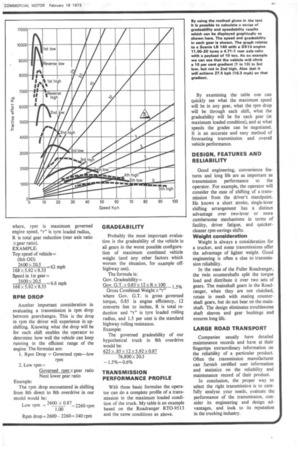YOU NEED TO KNOW ABOUT
Page 52

Page 53

If you've noticed an error in this article please click here to report it so we can fix it.
SPECIFYING THE RIGHT TRANSMISSION FOR YOUR TRUCK
by E. A Richards, chief engineer, transmission division, Eaton Corporation, USA
Last week in this series we dealt with some of the general points to be watched in specifying vehicles. One aspect of vehicle specification which can be particularly demanding is the selection of a transmission with the right ratios to give the vehicle the optimum performance on the routes and over the terrain which it is most likely to cover. In this second of two articles on vehicle selection, an American engineer explains the approach to transmission matching.
SUCCESSFUL HAULIERS virtually design their own heavy trucks by specifying the engine, transimssion, rear axles, tyres and other important components. They do this, if they are wise, after a rigorous appraisal of their requirements in terms of route, load, use, speed and cost. The reason for this is simple. Good operators know that time spent in careful planning is small in comparison with the money which can be lost or gained in long-term capital investment in trucks. They also know that the transmission is a critical link in the efficient operation of a truck. The ideal transmission enables the truck to operate at all times in the most economical operating range of the engine — that rpm range where fuel economy, torque and wear life are at a maximum. The appropriate transmission should also have long life and minimum maintenance characteristics. To do a thorough job of specifying a truck transmission, the operator must predict the performance of the transmission, and examine its design, features and reputation in the industry. To properly evaluate a transmission, the operator should forecast its performance within his requirements. But before he can do this, he will have to resolve a number of variables.
What's the load? For example, he must know what the usual load will be — high bulk or high density. If the cargo will be bulky, then air resistance can be greater than normal and the vehicle will need more horsepower at highway speeds. El The typical loading situation is important. Will the truck be 100 per cent loaded 50 per cent of the time, or 7080 per cent loaded 100 per cent of the time? This will have a bearing on horsepower, speed and gradeability of the vehicle. D There are route considerations. What are the maximum grades to be negotia ted? What speeds will have to be maintained to meet schedules? CI Then there are local regulations; radius of curves, height and width clearances which will largely determine the type of vehicle, whether straight or semi-trailer, and the gross combined weight. After making these considerations, the operator will know the type of vehicle, its gross combined weight, engine, tyre size, rear axle ratio and probable transmission. With this information, he can evaluate the transmission performance by using simple formulas to determine: speed, rpm drop between shifts, gradeability and an overall profile of the transmission performance. To set out the formulas and to demonstrate their use, let us assume we are evaluating a Fuller Roadranger RTO9513 transmission on a vehicle with the following specifications: Gross combination weight: 76,800lb (34.3 ton) Rear axle ratio: 5.92 to 1 Tyres: 11.00 by 20 Loaded rolling radius: 20.5in. Engine, diesel governed horsepower 320 bhp at 2600 rpm governed torque 6751b/ft at 2600 rpm RTO-9513 Transmission Capacity; 950 lb/ft Ratios: 8th OD 087 5th OD .... 2.14 8th DIR .... 1.00 5th DIR ... 2.47 7th OD .... 1.17 4th 3.38 7th DIR .... 1.35 3rd 4.56 6th OD 1 57 2nd 6.12 6th DIR .... 1.81 1st 8 35 LOW 12.50 VEHICLE SPEED The formula for calculating vehicle speed at maximum governed rpm is: d rpm x "r" 4R, sgPell.r 168 x R
where, rpm is maximum governed engine speed, "r" is tyre loaded radius, R is total gear reduction (rear axle ratio X gear ratio).
EXAMPLE: Top speed of vehicle= (8th OD)
2600X20'5 —62 mph 168 X 5.92 X 8.35 Speed in 1st gear= 2600x 20.5 —6.6 mph 168x 5.92X8.35 RPM DROP Another important consideration in evaluating a transmission is rpm drop between gearchanges. This is the drop in rpm the driver will experience in upshifting. Knowing what the drop will be for each shift enables the operator to determine how well the vehicle can keep running in the efficient range of the engine. The formulas are: 1. Rpm Drop = Governed rpm—low rpm 2. Low rpm=
Governed rpm X gear ratio Next lower gear ratio
Example: The rpm drop encountered in shifting from 8th direct to 8th overdrive in our model would be:
Low rpm 2600 x 0.87= 2260 rpm
1.00 Rpm drop= 2600— 2260= 340 rpm G RAD EAB I LITY Probably the most important evaluation is the gradeability of the vehicle in all gears in the worst possible configuration of maximum combined vehicle weight (and any other factors which worsen the situation, for example offhighway use).
The formula is: Gov. Gradeability=
Gov. G.T. X 0.85 X 12 xR x 100 1.5% Gross Combined Weight x "r"
where Gov. G.T. is gross governed torque, 0.85 is engine efficiency,12 converts feet to inches, R is total reduction and "r" is tyre loaded rolling radius, and 1.5 per cent is the standard highway rolling resistance.
Example: The governed gradeability of our hypothetical truck in 8th overdrive would be: 625x.85X12X5.92X0.87 76,800x 20.5 — 1.5%=0.6% TRANSMISSION PERFORMANCE PROFILE With these basic formulas the operator can do a complete profile of a transmission in the maximum loaded condition of the truck. My table is an example based on the Roadranger RTO-95 13 and the same conditions as above. By examining the table one can quickly see what the maximum speed will be in any gear, what the rpm drop will be through each shift, what the gradeability will be for each gear (at maximum loaded condition), and at what speeds the grades can be negotiated. It is an accurate and easy method of forecasting transmission and overall vehicle performance.
DESIGN, FEATURES AND RELIABILITY Good engineering, convenience features and long life are as important as transmission performance to the operator. For example, the operator will consider the ease of shifting of a transmission from the driver's standpoint. He knows a short stroke, single-lever shifting arrangement has a distinct advantage over two-lever or more cumbersome mechanisms in terms of facility, driver fatigue, and quickercleaner rpm-savings shifts.
Weight consideration Weight is always a consideration for a trucker, and some transmissions offer the advantage of lighter weight. Good engineering is often a clue to transmission reliability.
In the case of the Fuller Roadranger, the twin countershafts split the torque load and distribute it over two sets of gears. The mainshaft gears in the Roadranger, when they are not clutched, rotate in mesh with mating countershaft gears, but do not bear on the mainshaft. The design eliminates troublesome shaft sleeves and gear bushings and ensures long life.
LARGE ROAD TRANSPORT Companies usually have detailed maintenance records and have at their fingertips extraordinary information on the reliability of a particular product. Often the transmission manufacturer can furnish certified user information and statistics on the reliability and maintenance record of their product.
In conclusion, the proper way to select the right transmission is to carefully analyse your needs, evaluate the performance of the transmission, consider its engineering and design advantages, and look to its reputation in the trucking industry.












































































































